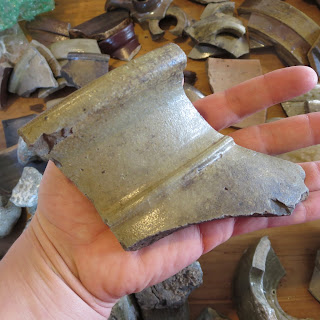What's even better? Nearly every piece in the box was individually wrapped!
There's an assortment of pieces from two creek banks on the eastern side of Boonville, Missouri. As I understand, there were a number of potters working along the creeks including Marcus Williams, George and Nicholas Valrath, Nicholas Lauer, H.W. Valrath, J.M Jegglin, and August A. Blanck. These potters worked at various times, but between the 1830s and the 1890s. The pieces from these various potters' operations tell so much about their kiln firings and their pottery production. Here are a few short highlights:
Who wouldn't be excited about a brick?!
It's not just any brick. It's likely a brick from a kiln as several surfaces on the brick show layers of wood ash and likely salt fumes.
In the photo above, check out the cross section of a thick layer of salt and wood ash built up on one side of the brick.
The above piece seems innocent enough, but it is so incredibly exciting to me.
It was a piece of kiln furniture that was at the early stages of its life going to be cut up into smaller pieces of kiln furniture. The cut pieces of kiln furniture that I was sent tended to all be about the same thickness.
Above is a rim showing the mark a small square piece of kiln furniture left on a piece when it was used in the kiln firing. In the roughly 35 different pre-1860 stoneware kiln sites I have looked at I have only seen small square pieces of kiln furniture used at 3 or 4 sites, and have observed it on some pieces of intact pottery. It's a tedious process making small squares (I know because I use them!), but they seem to serve a good purpose of covering a small area on the surface of the vessel, which makes it less likely that the pots would stick to one another along with the kiln furniture.
I was almost giddy when I saw the piece above. Can you guess what it is?
Hopefully the two views above may give you a better idea. It's two rims that got fused together with glaze. However, they were two rims from two bowls that were stacked, nested inside one another!
These bowls were similarly glazed to the bowl above- the underside of the exterior rim was dry, allowing the bowls to be nested inside of one another during the firing. I suppose if the base did not come in enough though, or the dry section of the underside of the rim was not wide enough, the glaze would fuse the pieces together. I sure hope there was not a large stack of bowls that suddenly became one giant stack!
The two photos above are great to see because it tells me something about the kiln firing. On the rivulets left by the wood ash and salt you can see tiny crystals. Crystals don't typically form on the surface unless the kiln has been cooled very slowly. When my kiln was first built and a little tighter, I recall having this occur just once on a few pieces after a heavily-salted firing. The kiln took a few more days than usual to cool and I got some crystals.
Though most kiln furniture was likely made during the loading and rolled and shaped to fit each various piece going in the kiln, the plethora of rim shapes and various shapes of kiln furniture made up never ceases to amaze and amuse me.
This particular piece just happened to nicely fit onto one of the rims in the box, so though it probably was not used together during a particular firing, it is possible that the two shapes came from the same pottery shop, so the kiln furniture would not have varied much from firing to firing.
Check out this post from a while back about making this shape of kiln furniture.
Jug stackers are always fun to find because it definitely gives you an idea of what the jugs would have looked like as a result of using them.
In other notes, we are avidly getting ready for our farm open house and pottery sale in a few weeks, so come visit if you are in the area!























1 comment:
What fun. You know you are my favorite Kiln Nerd ( not that there is a lot of competition for that title) I always found I could roll out slabs of wadding and cut them into squares a lot faster than I could make all the little balls. More consistency too. BTW Do you know what is so cool about sherds? If you drop them you have twice as many ! Have a great Farm Day and make that little guy charm the folks into buying some pots. I think he'll be good at it.
Post a Comment